Case Study: Human Capital Challenges in Lenovo-IBM Acquisition
VerifiedAdded on 2023/06/11
|22
|6176
|490
Report
AI Summary
This report examines the human capital aspects of Lenovo's acquisition of IBM's personal computer division, focusing on the organizational issues that arose post-acquisition. It compares the organizational cultures of Lenovo and IBM before the merger, highlighting differences in leadership styles and cultural values. The report analyzes challenges such as language barriers and cultural clashes, using Hofstede's cultural dimensions theory to explain the underlying issues. It discusses the resulting business problems, including communication breakdowns and decreased productivity, and explores potential solutions, such as improving cultural and emotional intelligence and enhancing communication strategies. The report emphasizes the importance of bridging the East-West culture gap to ensure the success of the acquisition and sustain productivity and profitability. This analysis is crucial for understanding the complexities of international mergers and the importance of effective human capital management.

Running head: HUMAN CAPITAL
Human Capital
Name of Student
Name of University
Author Note
Human Capital
Name of Student
Name of University
Author Note
Paraphrase This Document
Need a fresh take? Get an instant paraphrase of this document with our AI Paraphraser
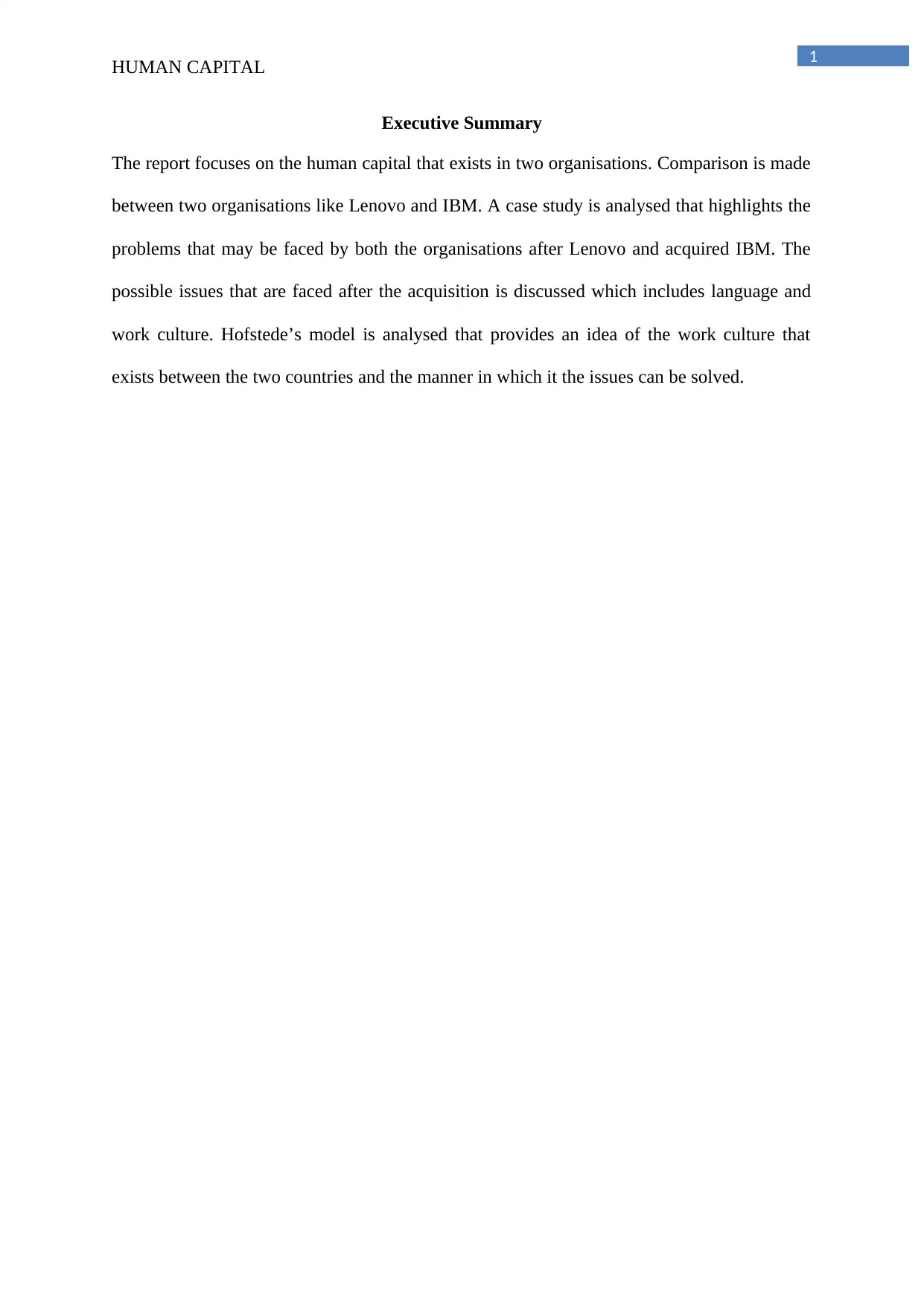
1
HUMAN CAPITAL
Executive Summary
The report focuses on the human capital that exists in two organisations. Comparison is made
between two organisations like Lenovo and IBM. A case study is analysed that highlights the
problems that may be faced by both the organisations after Lenovo and acquired IBM. The
possible issues that are faced after the acquisition is discussed which includes language and
work culture. Hofstede’s model is analysed that provides an idea of the work culture that
exists between the two countries and the manner in which it the issues can be solved.
HUMAN CAPITAL
Executive Summary
The report focuses on the human capital that exists in two organisations. Comparison is made
between two organisations like Lenovo and IBM. A case study is analysed that highlights the
problems that may be faced by both the organisations after Lenovo and acquired IBM. The
possible issues that are faced after the acquisition is discussed which includes language and
work culture. Hofstede’s model is analysed that provides an idea of the work culture that
exists between the two countries and the manner in which it the issues can be solved.
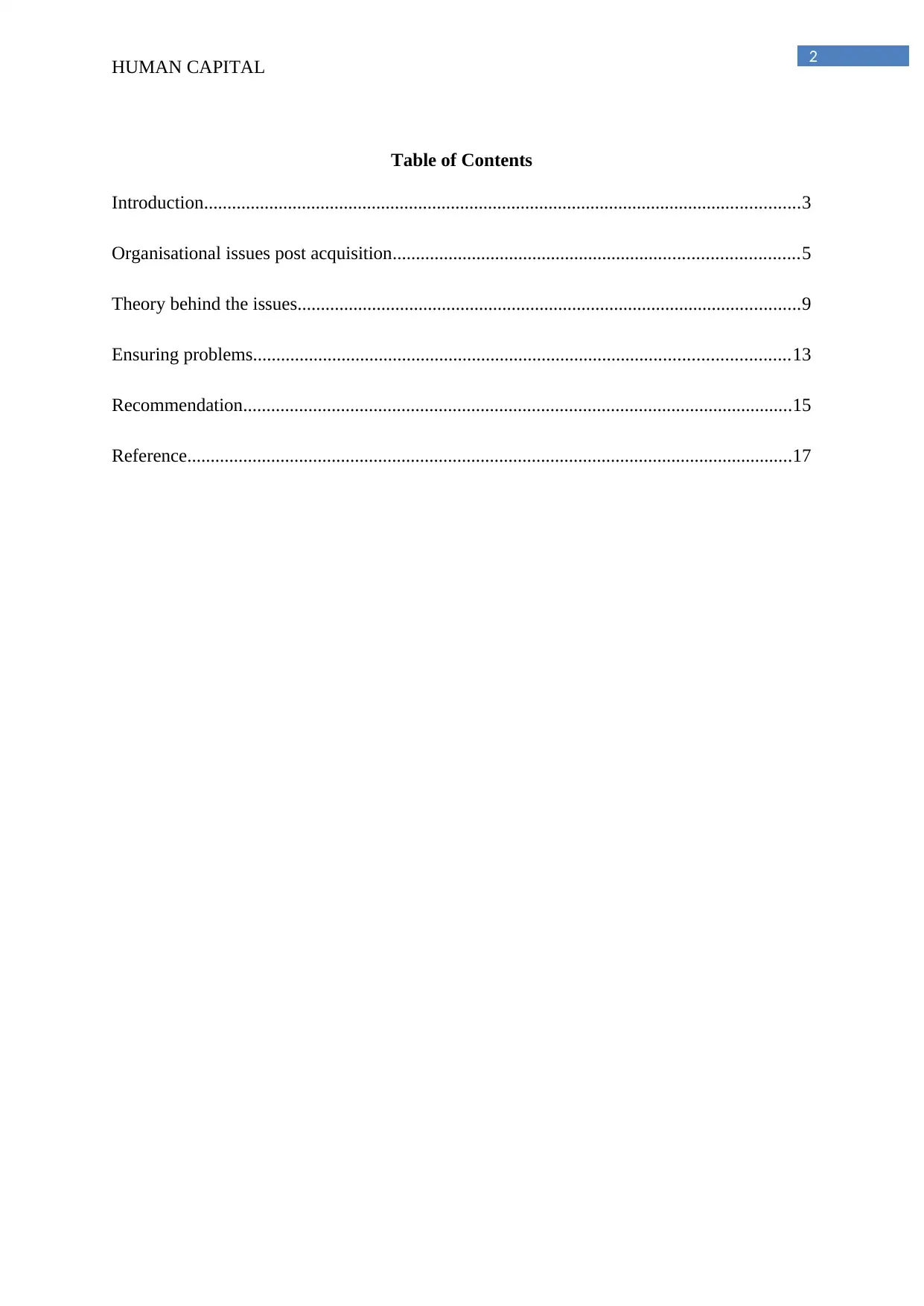
2
HUMAN CAPITAL
Table of Contents
Introduction................................................................................................................................3
Organisational issues post acquisition.......................................................................................5
Theory behind the issues............................................................................................................9
Ensuring problems...................................................................................................................13
Recommendation......................................................................................................................15
Reference..................................................................................................................................17
HUMAN CAPITAL
Table of Contents
Introduction................................................................................................................................3
Organisational issues post acquisition.......................................................................................5
Theory behind the issues............................................................................................................9
Ensuring problems...................................................................................................................13
Recommendation......................................................................................................................15
Reference..................................................................................................................................17
⊘ This is a preview!⊘
Do you want full access?
Subscribe today to unlock all pages.

Trusted by 1+ million students worldwide
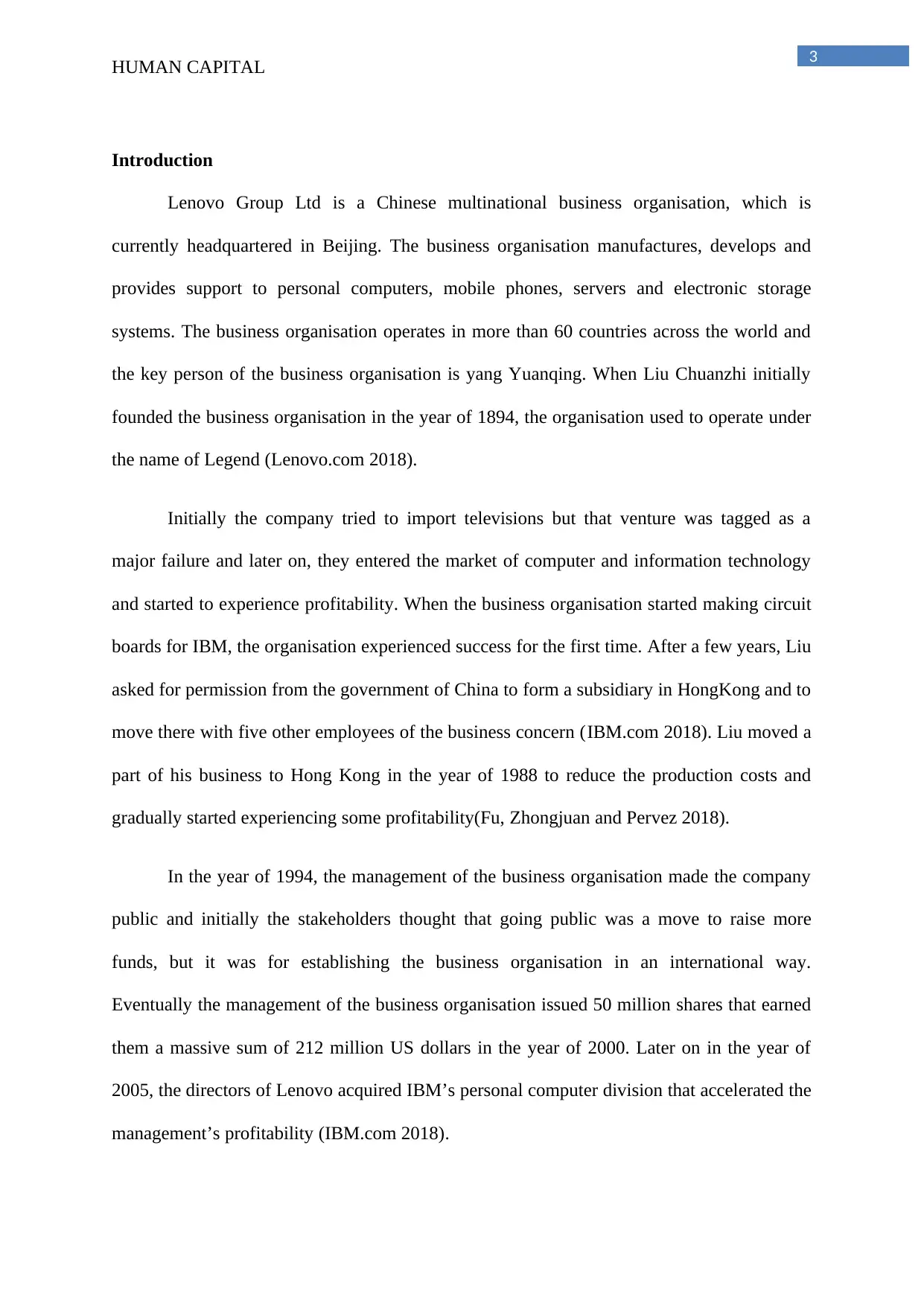
3
HUMAN CAPITAL
Introduction
Lenovo Group Ltd is a Chinese multinational business organisation, which is
currently headquartered in Beijing. The business organisation manufactures, develops and
provides support to personal computers, mobile phones, servers and electronic storage
systems. The business organisation operates in more than 60 countries across the world and
the key person of the business organisation is yang Yuanqing. When Liu Chuanzhi initially
founded the business organisation in the year of 1894, the organisation used to operate under
the name of Legend (Lenovo.com 2018).
Initially the company tried to import televisions but that venture was tagged as a
major failure and later on, they entered the market of computer and information technology
and started to experience profitability. When the business organisation started making circuit
boards for IBM, the organisation experienced success for the first time. After a few years, Liu
asked for permission from the government of China to form a subsidiary in HongKong and to
move there with five other employees of the business concern (IBM.com 2018). Liu moved a
part of his business to Hong Kong in the year of 1988 to reduce the production costs and
gradually started experiencing some profitability(Fu, Zhongjuan and Pervez 2018).
In the year of 1994, the management of the business organisation made the company
public and initially the stakeholders thought that going public was a move to raise more
funds, but it was for establishing the business organisation in an international way.
Eventually the management of the business organisation issued 50 million shares that earned
them a massive sum of 212 million US dollars in the year of 2000. Later on in the year of
2005, the directors of Lenovo acquired IBM’s personal computer division that accelerated the
management’s profitability (IBM.com 2018).
HUMAN CAPITAL
Introduction
Lenovo Group Ltd is a Chinese multinational business organisation, which is
currently headquartered in Beijing. The business organisation manufactures, develops and
provides support to personal computers, mobile phones, servers and electronic storage
systems. The business organisation operates in more than 60 countries across the world and
the key person of the business organisation is yang Yuanqing. When Liu Chuanzhi initially
founded the business organisation in the year of 1894, the organisation used to operate under
the name of Legend (Lenovo.com 2018).
Initially the company tried to import televisions but that venture was tagged as a
major failure and later on, they entered the market of computer and information technology
and started to experience profitability. When the business organisation started making circuit
boards for IBM, the organisation experienced success for the first time. After a few years, Liu
asked for permission from the government of China to form a subsidiary in HongKong and to
move there with five other employees of the business concern (IBM.com 2018). Liu moved a
part of his business to Hong Kong in the year of 1988 to reduce the production costs and
gradually started experiencing some profitability(Fu, Zhongjuan and Pervez 2018).
In the year of 1994, the management of the business organisation made the company
public and initially the stakeholders thought that going public was a move to raise more
funds, but it was for establishing the business organisation in an international way.
Eventually the management of the business organisation issued 50 million shares that earned
them a massive sum of 212 million US dollars in the year of 2000. Later on in the year of
2005, the directors of Lenovo acquired IBM’s personal computer division that accelerated the
management’s profitability (IBM.com 2018).
Paraphrase This Document
Need a fresh take? Get an instant paraphrase of this document with our AI Paraphraser
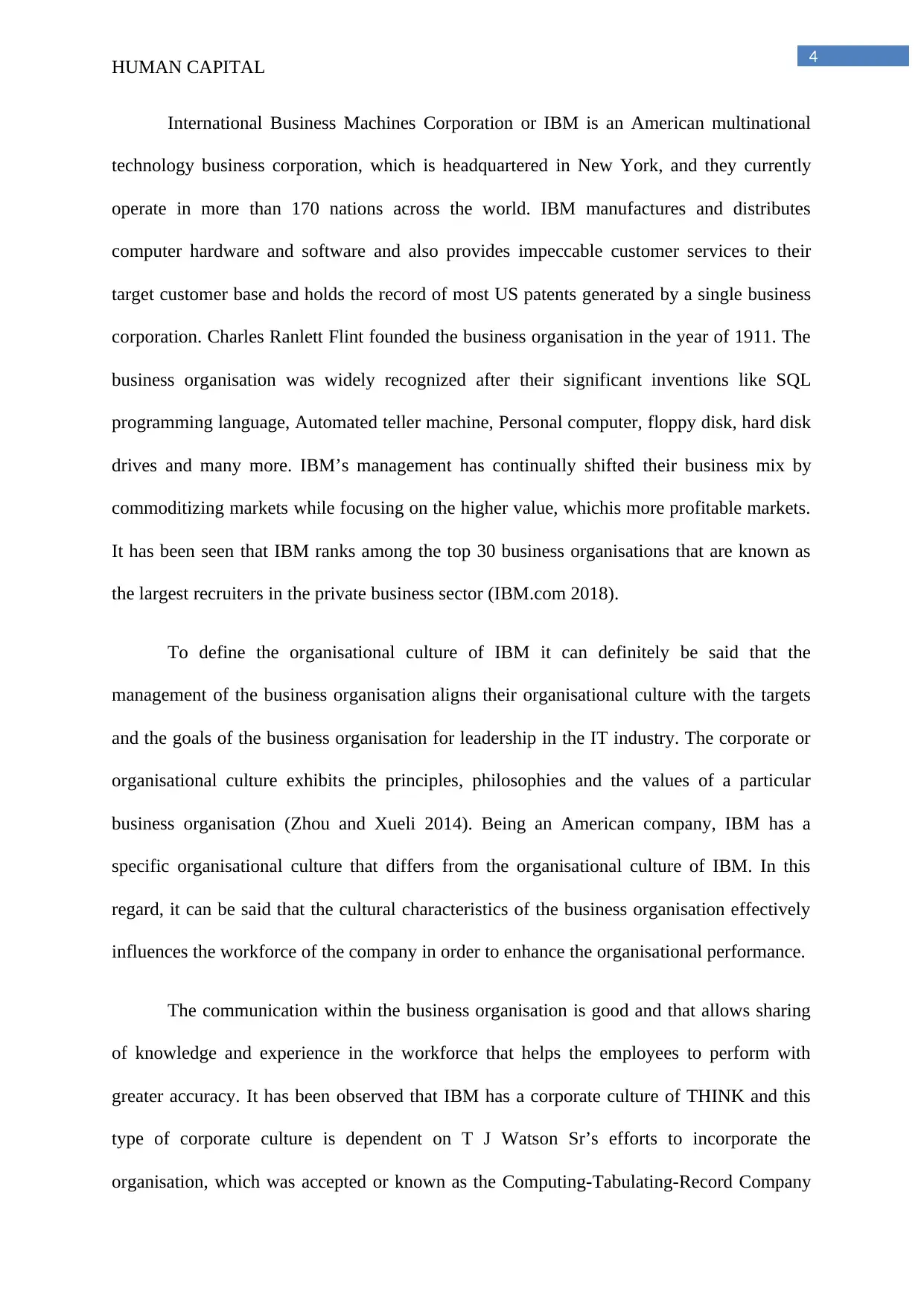
4
HUMAN CAPITAL
International Business Machines Corporation or IBM is an American multinational
technology business corporation, which is headquartered in New York, and they currently
operate in more than 170 nations across the world. IBM manufactures and distributes
computer hardware and software and also provides impeccable customer services to their
target customer base and holds the record of most US patents generated by a single business
corporation. Charles Ranlett Flint founded the business organisation in the year of 1911. The
business organisation was widely recognized after their significant inventions like SQL
programming language, Automated teller machine, Personal computer, floppy disk, hard disk
drives and many more. IBM’s management has continually shifted their business mix by
commoditizing markets while focusing on the higher value, whichis more profitable markets.
It has been seen that IBM ranks among the top 30 business organisations that are known as
the largest recruiters in the private business sector (IBM.com 2018).
To define the organisational culture of IBM it can definitely be said that the
management of the business organisation aligns their organisational culture with the targets
and the goals of the business organisation for leadership in the IT industry. The corporate or
organisational culture exhibits the principles, philosophies and the values of a particular
business organisation (Zhou and Xueli 2014). Being an American company, IBM has a
specific organisational culture that differs from the organisational culture of IBM. In this
regard, it can be said that the cultural characteristics of the business organisation effectively
influences the workforce of the company in order to enhance the organisational performance.
The communication within the business organisation is good and that allows sharing
of knowledge and experience in the workforce that helps the employees to perform with
greater accuracy. It has been observed that IBM has a corporate culture of THINK and this
type of corporate culture is dependent on T J Watson Sr’s efforts to incorporate the
organisation, which was accepted or known as the Computing-Tabulating-Record Company
HUMAN CAPITAL
International Business Machines Corporation or IBM is an American multinational
technology business corporation, which is headquartered in New York, and they currently
operate in more than 170 nations across the world. IBM manufactures and distributes
computer hardware and software and also provides impeccable customer services to their
target customer base and holds the record of most US patents generated by a single business
corporation. Charles Ranlett Flint founded the business organisation in the year of 1911. The
business organisation was widely recognized after their significant inventions like SQL
programming language, Automated teller machine, Personal computer, floppy disk, hard disk
drives and many more. IBM’s management has continually shifted their business mix by
commoditizing markets while focusing on the higher value, whichis more profitable markets.
It has been seen that IBM ranks among the top 30 business organisations that are known as
the largest recruiters in the private business sector (IBM.com 2018).
To define the organisational culture of IBM it can definitely be said that the
management of the business organisation aligns their organisational culture with the targets
and the goals of the business organisation for leadership in the IT industry. The corporate or
organisational culture exhibits the principles, philosophies and the values of a particular
business organisation (Zhou and Xueli 2014). Being an American company, IBM has a
specific organisational culture that differs from the organisational culture of IBM. In this
regard, it can be said that the cultural characteristics of the business organisation effectively
influences the workforce of the company in order to enhance the organisational performance.
The communication within the business organisation is good and that allows sharing
of knowledge and experience in the workforce that helps the employees to perform with
greater accuracy. It has been observed that IBM has a corporate culture of THINK and this
type of corporate culture is dependent on T J Watson Sr’s efforts to incorporate the
organisation, which was accepted or known as the Computing-Tabulating-Record Company
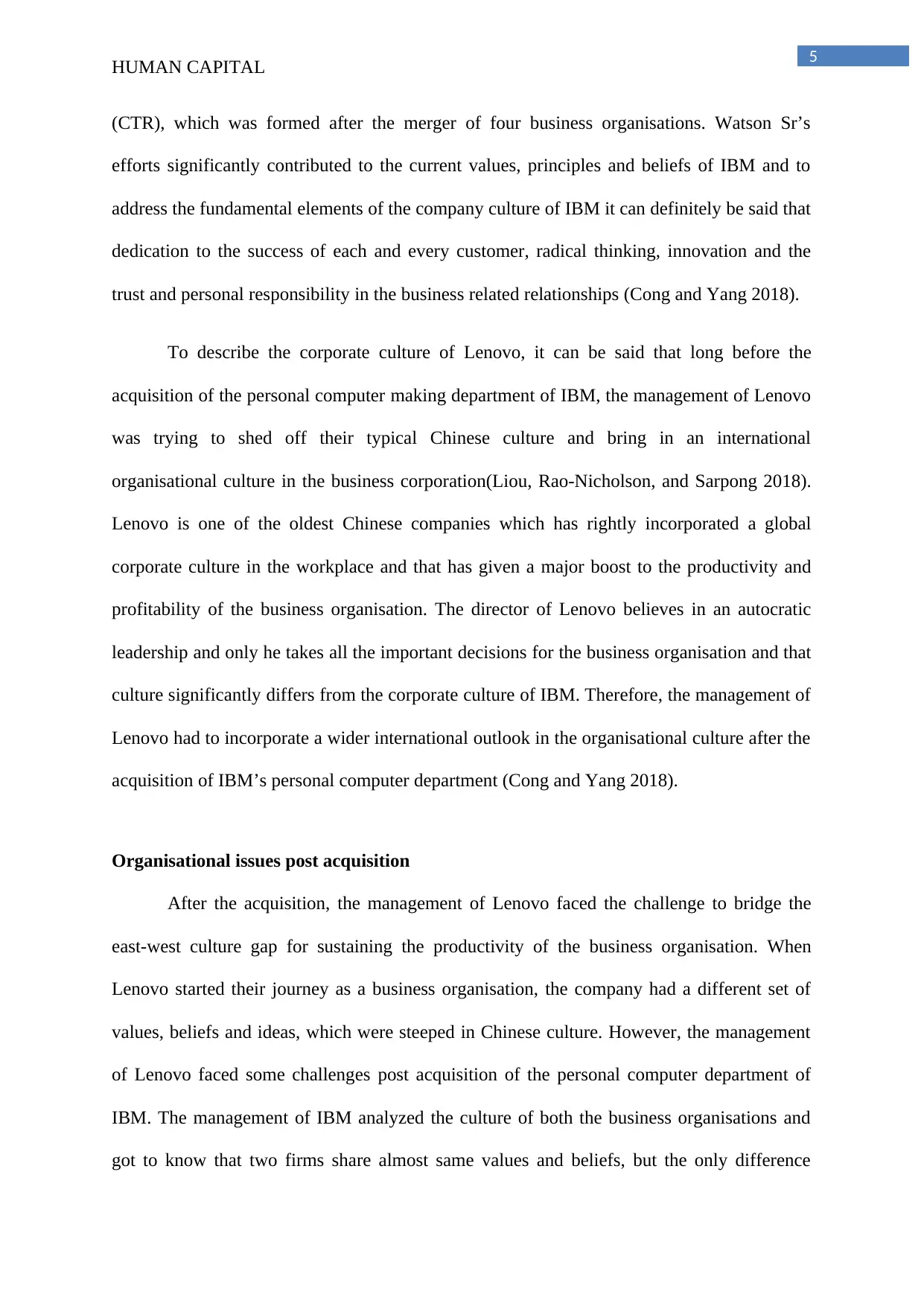
5
HUMAN CAPITAL
(CTR), which was formed after the merger of four business organisations. Watson Sr’s
efforts significantly contributed to the current values, principles and beliefs of IBM and to
address the fundamental elements of the company culture of IBM it can definitely be said that
dedication to the success of each and every customer, radical thinking, innovation and the
trust and personal responsibility in the business related relationships (Cong and Yang 2018).
To describe the corporate culture of Lenovo, it can be said that long before the
acquisition of the personal computer making department of IBM, the management of Lenovo
was trying to shed off their typical Chinese culture and bring in an international
organisational culture in the business corporation(Liou, Rao-Nicholson, and Sarpong 2018).
Lenovo is one of the oldest Chinese companies which has rightly incorporated a global
corporate culture in the workplace and that has given a major boost to the productivity and
profitability of the business organisation. The director of Lenovo believes in an autocratic
leadership and only he takes all the important decisions for the business organisation and that
culture significantly differs from the corporate culture of IBM. Therefore, the management of
Lenovo had to incorporate a wider international outlook in the organisational culture after the
acquisition of IBM’s personal computer department (Cong and Yang 2018).
Organisational issues post acquisition
After the acquisition, the management of Lenovo faced the challenge to bridge the
east-west culture gap for sustaining the productivity of the business organisation. When
Lenovo started their journey as a business organisation, the company had a different set of
values, beliefs and ideas, which were steeped in Chinese culture. However, the management
of Lenovo faced some challenges post acquisition of the personal computer department of
IBM. The management of IBM analyzed the culture of both the business organisations and
got to know that two firms share almost same values and beliefs, but the only difference
HUMAN CAPITAL
(CTR), which was formed after the merger of four business organisations. Watson Sr’s
efforts significantly contributed to the current values, principles and beliefs of IBM and to
address the fundamental elements of the company culture of IBM it can definitely be said that
dedication to the success of each and every customer, radical thinking, innovation and the
trust and personal responsibility in the business related relationships (Cong and Yang 2018).
To describe the corporate culture of Lenovo, it can be said that long before the
acquisition of the personal computer making department of IBM, the management of Lenovo
was trying to shed off their typical Chinese culture and bring in an international
organisational culture in the business corporation(Liou, Rao-Nicholson, and Sarpong 2018).
Lenovo is one of the oldest Chinese companies which has rightly incorporated a global
corporate culture in the workplace and that has given a major boost to the productivity and
profitability of the business organisation. The director of Lenovo believes in an autocratic
leadership and only he takes all the important decisions for the business organisation and that
culture significantly differs from the corporate culture of IBM. Therefore, the management of
Lenovo had to incorporate a wider international outlook in the organisational culture after the
acquisition of IBM’s personal computer department (Cong and Yang 2018).
Organisational issues post acquisition
After the acquisition, the management of Lenovo faced the challenge to bridge the
east-west culture gap for sustaining the productivity of the business organisation. When
Lenovo started their journey as a business organisation, the company had a different set of
values, beliefs and ideas, which were steeped in Chinese culture. However, the management
of Lenovo faced some challenges post acquisition of the personal computer department of
IBM. The management of IBM analyzed the culture of both the business organisations and
got to know that two firms share almost same values and beliefs, but the only difference
⊘ This is a preview!⊘
Do you want full access?
Subscribe today to unlock all pages.

Trusted by 1+ million students worldwide
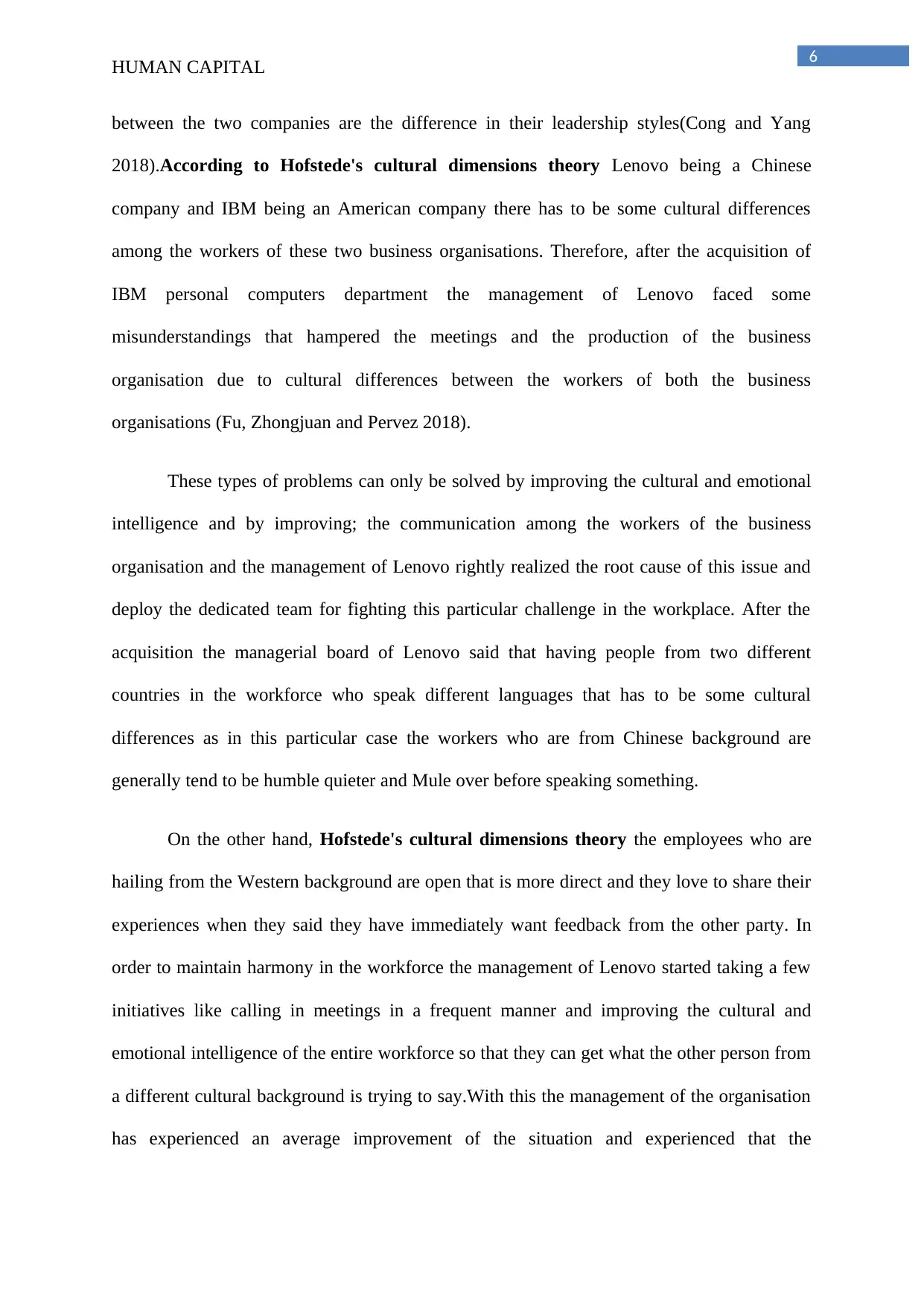
6
HUMAN CAPITAL
between the two companies are the difference in their leadership styles(Cong and Yang
2018).According to Hofstede's cultural dimensions theory Lenovo being a Chinese
company and IBM being an American company there has to be some cultural differences
among the workers of these two business organisations. Therefore, after the acquisition of
IBM personal computers department the management of Lenovo faced some
misunderstandings that hampered the meetings and the production of the business
organisation due to cultural differences between the workers of both the business
organisations (Fu, Zhongjuan and Pervez 2018).
These types of problems can only be solved by improving the cultural and emotional
intelligence and by improving; the communication among the workers of the business
organisation and the management of Lenovo rightly realized the root cause of this issue and
deploy the dedicated team for fighting this particular challenge in the workplace. After the
acquisition the managerial board of Lenovo said that having people from two different
countries in the workforce who speak different languages that has to be some cultural
differences as in this particular case the workers who are from Chinese background are
generally tend to be humble quieter and Mule over before speaking something.
On the other hand, Hofstede's cultural dimensions theory the employees who are
hailing from the Western background are open that is more direct and they love to share their
experiences when they said they have immediately want feedback from the other party. In
order to maintain harmony in the workforce the management of Lenovo started taking a few
initiatives like calling in meetings in a frequent manner and improving the cultural and
emotional intelligence of the entire workforce so that they can get what the other person from
a different cultural background is trying to say.With this the management of the organisation
has experienced an average improvement of the situation and experienced that the
HUMAN CAPITAL
between the two companies are the difference in their leadership styles(Cong and Yang
2018).According to Hofstede's cultural dimensions theory Lenovo being a Chinese
company and IBM being an American company there has to be some cultural differences
among the workers of these two business organisations. Therefore, after the acquisition of
IBM personal computers department the management of Lenovo faced some
misunderstandings that hampered the meetings and the production of the business
organisation due to cultural differences between the workers of both the business
organisations (Fu, Zhongjuan and Pervez 2018).
These types of problems can only be solved by improving the cultural and emotional
intelligence and by improving; the communication among the workers of the business
organisation and the management of Lenovo rightly realized the root cause of this issue and
deploy the dedicated team for fighting this particular challenge in the workplace. After the
acquisition the managerial board of Lenovo said that having people from two different
countries in the workforce who speak different languages that has to be some cultural
differences as in this particular case the workers who are from Chinese background are
generally tend to be humble quieter and Mule over before speaking something.
On the other hand, Hofstede's cultural dimensions theory the employees who are
hailing from the Western background are open that is more direct and they love to share their
experiences when they said they have immediately want feedback from the other party. In
order to maintain harmony in the workforce the management of Lenovo started taking a few
initiatives like calling in meetings in a frequent manner and improving the cultural and
emotional intelligence of the entire workforce so that they can get what the other person from
a different cultural background is trying to say.With this the management of the organisation
has experienced an average improvement of the situation and experienced that the
Paraphrase This Document
Need a fresh take? Get an instant paraphrase of this document with our AI Paraphraser
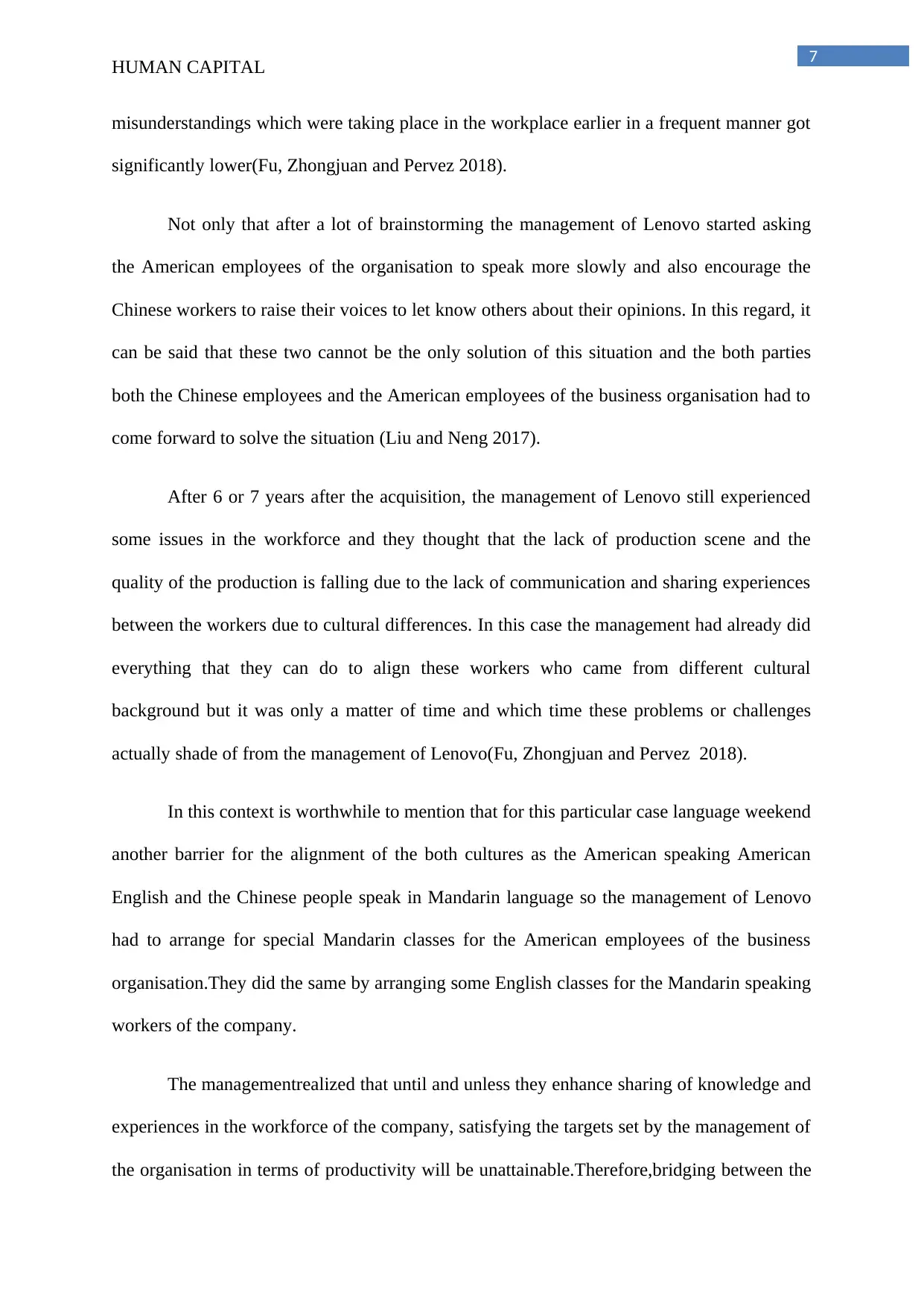
7
HUMAN CAPITAL
misunderstandings which were taking place in the workplace earlier in a frequent manner got
significantly lower(Fu, Zhongjuan and Pervez 2018).
Not only that after a lot of brainstorming the management of Lenovo started asking
the American employees of the organisation to speak more slowly and also encourage the
Chinese workers to raise their voices to let know others about their opinions. In this regard, it
can be said that these two cannot be the only solution of this situation and the both parties
both the Chinese employees and the American employees of the business organisation had to
come forward to solve the situation (Liu and Neng 2017).
After 6 or 7 years after the acquisition, the management of Lenovo still experienced
some issues in the workforce and they thought that the lack of production scene and the
quality of the production is falling due to the lack of communication and sharing experiences
between the workers due to cultural differences. In this case the management had already did
everything that they can do to align these workers who came from different cultural
background but it was only a matter of time and which time these problems or challenges
actually shade of from the management of Lenovo(Fu, Zhongjuan and Pervez 2018).
In this context is worthwhile to mention that for this particular case language weekend
another barrier for the alignment of the both cultures as the American speaking American
English and the Chinese people speak in Mandarin language so the management of Lenovo
had to arrange for special Mandarin classes for the American employees of the business
organisation.They did the same by arranging some English classes for the Mandarin speaking
workers of the company.
The managementrealized that until and unless they enhance sharing of knowledge and
experiences in the workforce of the company, satisfying the targets set by the management of
the organisation in terms of productivity will be unattainable.Therefore,bridging between the
HUMAN CAPITAL
misunderstandings which were taking place in the workplace earlier in a frequent manner got
significantly lower(Fu, Zhongjuan and Pervez 2018).
Not only that after a lot of brainstorming the management of Lenovo started asking
the American employees of the organisation to speak more slowly and also encourage the
Chinese workers to raise their voices to let know others about their opinions. In this regard, it
can be said that these two cannot be the only solution of this situation and the both parties
both the Chinese employees and the American employees of the business organisation had to
come forward to solve the situation (Liu and Neng 2017).
After 6 or 7 years after the acquisition, the management of Lenovo still experienced
some issues in the workforce and they thought that the lack of production scene and the
quality of the production is falling due to the lack of communication and sharing experiences
between the workers due to cultural differences. In this case the management had already did
everything that they can do to align these workers who came from different cultural
background but it was only a matter of time and which time these problems or challenges
actually shade of from the management of Lenovo(Fu, Zhongjuan and Pervez 2018).
In this context is worthwhile to mention that for this particular case language weekend
another barrier for the alignment of the both cultures as the American speaking American
English and the Chinese people speak in Mandarin language so the management of Lenovo
had to arrange for special Mandarin classes for the American employees of the business
organisation.They did the same by arranging some English classes for the Mandarin speaking
workers of the company.
The managementrealized that until and unless they enhance sharing of knowledge and
experiences in the workforce of the company, satisfying the targets set by the management of
the organisation in terms of productivity will be unattainable.Therefore,bridging between the
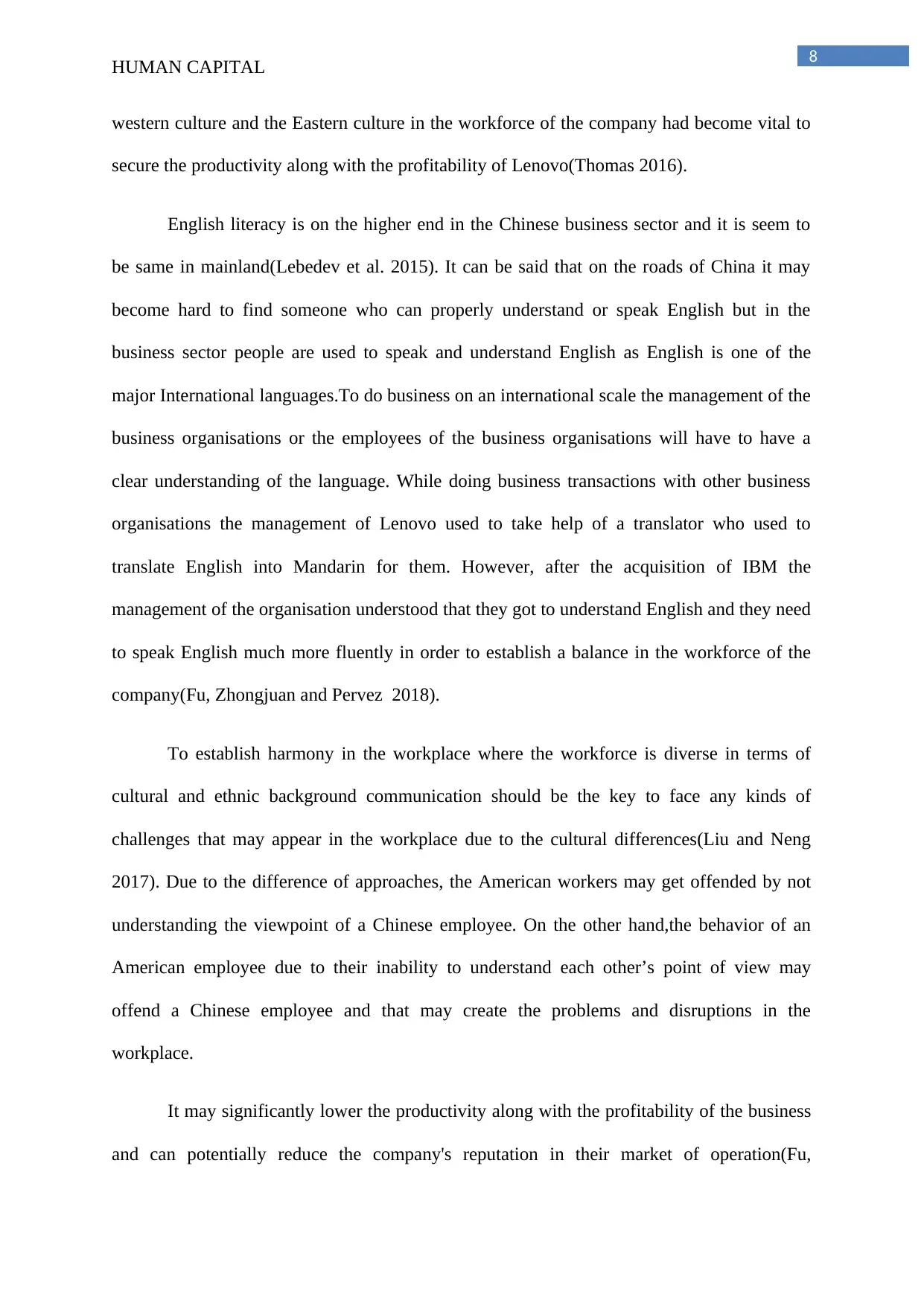
8
HUMAN CAPITAL
western culture and the Eastern culture in the workforce of the company had become vital to
secure the productivity along with the profitability of Lenovo(Thomas 2016).
English literacy is on the higher end in the Chinese business sector and it is seem to
be same in mainland(Lebedev et al. 2015). It can be said that on the roads of China it may
become hard to find someone who can properly understand or speak English but in the
business sector people are used to speak and understand English as English is one of the
major International languages.To do business on an international scale the management of the
business organisations or the employees of the business organisations will have to have a
clear understanding of the language. While doing business transactions with other business
organisations the management of Lenovo used to take help of a translator who used to
translate English into Mandarin for them. However, after the acquisition of IBM the
management of the organisation understood that they got to understand English and they need
to speak English much more fluently in order to establish a balance in the workforce of the
company(Fu, Zhongjuan and Pervez 2018).
To establish harmony in the workplace where the workforce is diverse in terms of
cultural and ethnic background communication should be the key to face any kinds of
challenges that may appear in the workplace due to the cultural differences(Liu and Neng
2017). Due to the difference of approaches, the American workers may get offended by not
understanding the viewpoint of a Chinese employee. On the other hand,the behavior of an
American employee due to their inability to understand each other’s point of view may
offend a Chinese employee and that may create the problems and disruptions in the
workplace.
It may significantly lower the productivity along with the profitability of the business
and can potentially reduce the company's reputation in their market of operation(Fu,
HUMAN CAPITAL
western culture and the Eastern culture in the workforce of the company had become vital to
secure the productivity along with the profitability of Lenovo(Thomas 2016).
English literacy is on the higher end in the Chinese business sector and it is seem to
be same in mainland(Lebedev et al. 2015). It can be said that on the roads of China it may
become hard to find someone who can properly understand or speak English but in the
business sector people are used to speak and understand English as English is one of the
major International languages.To do business on an international scale the management of the
business organisations or the employees of the business organisations will have to have a
clear understanding of the language. While doing business transactions with other business
organisations the management of Lenovo used to take help of a translator who used to
translate English into Mandarin for them. However, after the acquisition of IBM the
management of the organisation understood that they got to understand English and they need
to speak English much more fluently in order to establish a balance in the workforce of the
company(Fu, Zhongjuan and Pervez 2018).
To establish harmony in the workplace where the workforce is diverse in terms of
cultural and ethnic background communication should be the key to face any kinds of
challenges that may appear in the workplace due to the cultural differences(Liu and Neng
2017). Due to the difference of approaches, the American workers may get offended by not
understanding the viewpoint of a Chinese employee. On the other hand,the behavior of an
American employee due to their inability to understand each other’s point of view may
offend a Chinese employee and that may create the problems and disruptions in the
workplace.
It may significantly lower the productivity along with the profitability of the business
and can potentially reduce the company's reputation in their market of operation(Fu,
⊘ This is a preview!⊘
Do you want full access?
Subscribe today to unlock all pages.

Trusted by 1+ million students worldwide
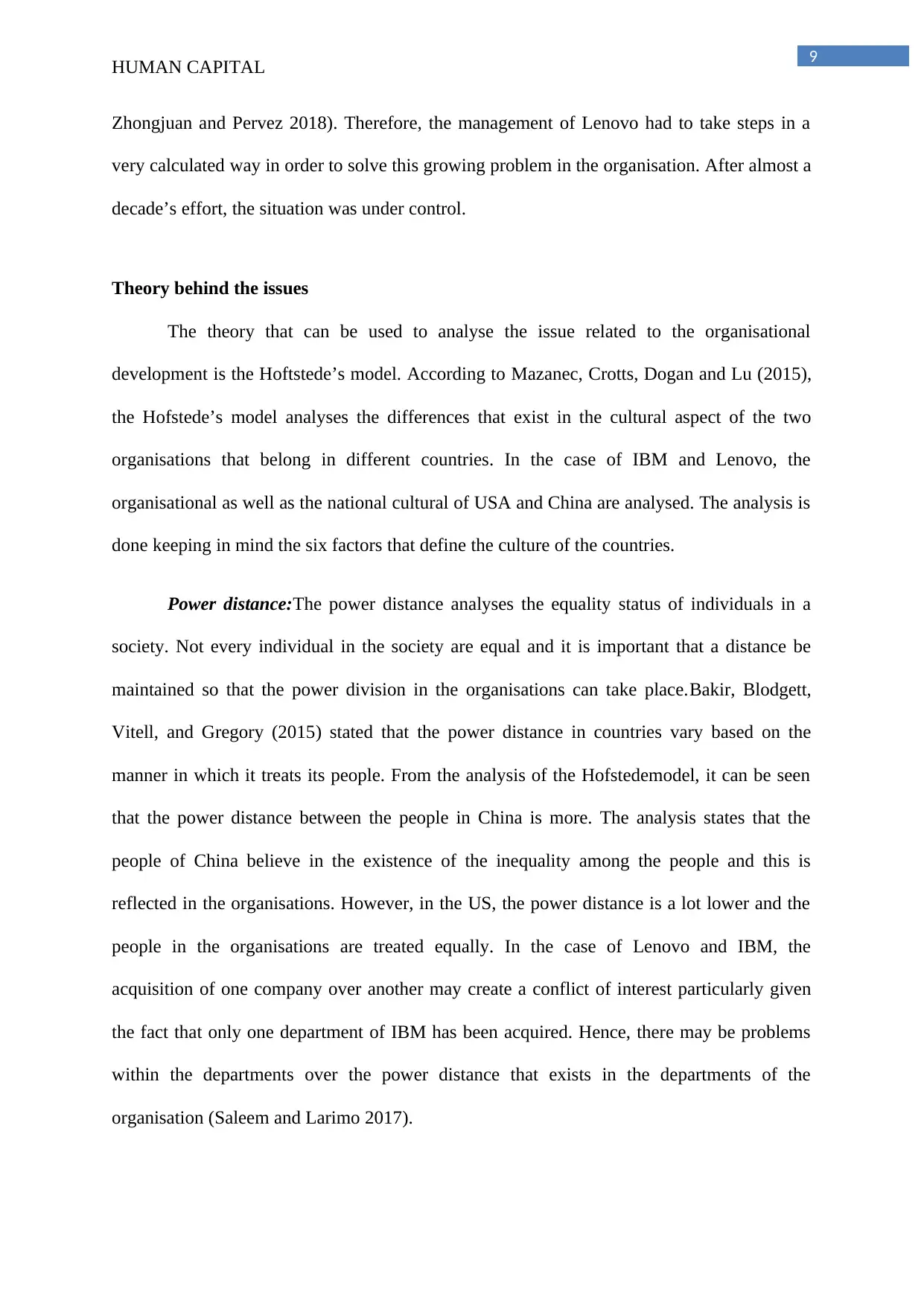
9
HUMAN CAPITAL
Zhongjuan and Pervez 2018). Therefore, the management of Lenovo had to take steps in a
very calculated way in order to solve this growing problem in the organisation. After almost a
decade’s effort, the situation was under control.
Theory behind the issues
The theory that can be used to analyse the issue related to the organisational
development is the Hoftstede’s model. According to Mazanec, Crotts, Dogan and Lu (2015),
the Hofstede’s model analyses the differences that exist in the cultural aspect of the two
organisations that belong in different countries. In the case of IBM and Lenovo, the
organisational as well as the national cultural of USA and China are analysed. The analysis is
done keeping in mind the six factors that define the culture of the countries.
Power distance:The power distance analyses the equality status of individuals in a
society. Not every individual in the society are equal and it is important that a distance be
maintained so that the power division in the organisations can take place.Bakir, Blodgett,
Vitell, and Gregory (2015) stated that the power distance in countries vary based on the
manner in which it treats its people. From the analysis of the Hofstedemodel, it can be seen
that the power distance between the people in China is more. The analysis states that the
people of China believe in the existence of the inequality among the people and this is
reflected in the organisations. However, in the US, the power distance is a lot lower and the
people in the organisations are treated equally. In the case of Lenovo and IBM, the
acquisition of one company over another may create a conflict of interest particularly given
the fact that only one department of IBM has been acquired. Hence, there may be problems
within the departments over the power distance that exists in the departments of the
organisation (Saleem and Larimo 2017).
HUMAN CAPITAL
Zhongjuan and Pervez 2018). Therefore, the management of Lenovo had to take steps in a
very calculated way in order to solve this growing problem in the organisation. After almost a
decade’s effort, the situation was under control.
Theory behind the issues
The theory that can be used to analyse the issue related to the organisational
development is the Hoftstede’s model. According to Mazanec, Crotts, Dogan and Lu (2015),
the Hofstede’s model analyses the differences that exist in the cultural aspect of the two
organisations that belong in different countries. In the case of IBM and Lenovo, the
organisational as well as the national cultural of USA and China are analysed. The analysis is
done keeping in mind the six factors that define the culture of the countries.
Power distance:The power distance analyses the equality status of individuals in a
society. Not every individual in the society are equal and it is important that a distance be
maintained so that the power division in the organisations can take place.Bakir, Blodgett,
Vitell, and Gregory (2015) stated that the power distance in countries vary based on the
manner in which it treats its people. From the analysis of the Hofstedemodel, it can be seen
that the power distance between the people in China is more. The analysis states that the
people of China believe in the existence of the inequality among the people and this is
reflected in the organisations. However, in the US, the power distance is a lot lower and the
people in the organisations are treated equally. In the case of Lenovo and IBM, the
acquisition of one company over another may create a conflict of interest particularly given
the fact that only one department of IBM has been acquired. Hence, there may be problems
within the departments over the power distance that exists in the departments of the
organisation (Saleem and Larimo 2017).
Paraphrase This Document
Need a fresh take? Get an instant paraphrase of this document with our AI Paraphraser
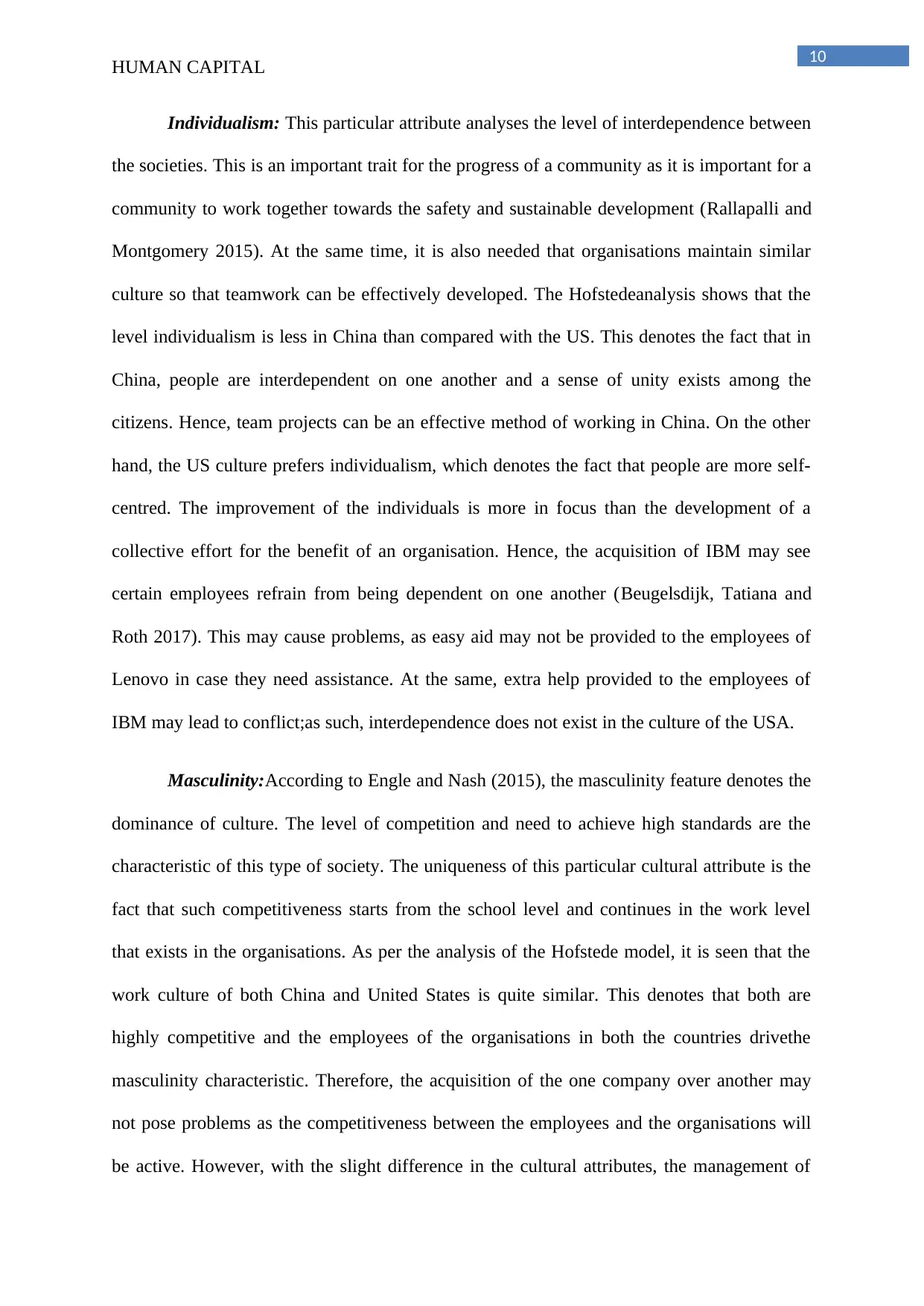
10
HUMAN CAPITAL
Individualism: This particular attribute analyses the level of interdependence between
the societies. This is an important trait for the progress of a community as it is important for a
community to work together towards the safety and sustainable development (Rallapalli and
Montgomery 2015). At the same time, it is also needed that organisations maintain similar
culture so that teamwork can be effectively developed. The Hofstedeanalysis shows that the
level individualism is less in China than compared with the US. This denotes the fact that in
China, people are interdependent on one another and a sense of unity exists among the
citizens. Hence, team projects can be an effective method of working in China. On the other
hand, the US culture prefers individualism, which denotes the fact that people are more self-
centred. The improvement of the individuals is more in focus than the development of a
collective effort for the benefit of an organisation. Hence, the acquisition of IBM may see
certain employees refrain from being dependent on one another (Beugelsdijk, Tatiana and
Roth 2017). This may cause problems, as easy aid may not be provided to the employees of
Lenovo in case they need assistance. At the same, extra help provided to the employees of
IBM may lead to conflict;as such, interdependence does not exist in the culture of the USA.
Masculinity:According to Engle and Nash (2015), the masculinity feature denotes the
dominance of culture. The level of competition and need to achieve high standards are the
characteristic of this type of society. The uniqueness of this particular cultural attribute is the
fact that such competitiveness starts from the school level and continues in the work level
that exists in the organisations. As per the analysis of the Hofstede model, it is seen that the
work culture of both China and United States is quite similar. This denotes that both are
highly competitive and the employees of the organisations in both the countries drivethe
masculinity characteristic. Therefore, the acquisition of the one company over another may
not pose problems as the competitiveness between the employees and the organisations will
be active. However, with the slight difference in the cultural attributes, the management of
HUMAN CAPITAL
Individualism: This particular attribute analyses the level of interdependence between
the societies. This is an important trait for the progress of a community as it is important for a
community to work together towards the safety and sustainable development (Rallapalli and
Montgomery 2015). At the same time, it is also needed that organisations maintain similar
culture so that teamwork can be effectively developed. The Hofstedeanalysis shows that the
level individualism is less in China than compared with the US. This denotes the fact that in
China, people are interdependent on one another and a sense of unity exists among the
citizens. Hence, team projects can be an effective method of working in China. On the other
hand, the US culture prefers individualism, which denotes the fact that people are more self-
centred. The improvement of the individuals is more in focus than the development of a
collective effort for the benefit of an organisation. Hence, the acquisition of IBM may see
certain employees refrain from being dependent on one another (Beugelsdijk, Tatiana and
Roth 2017). This may cause problems, as easy aid may not be provided to the employees of
Lenovo in case they need assistance. At the same, extra help provided to the employees of
IBM may lead to conflict;as such, interdependence does not exist in the culture of the USA.
Masculinity:According to Engle and Nash (2015), the masculinity feature denotes the
dominance of culture. The level of competition and need to achieve high standards are the
characteristic of this type of society. The uniqueness of this particular cultural attribute is the
fact that such competitiveness starts from the school level and continues in the work level
that exists in the organisations. As per the analysis of the Hofstede model, it is seen that the
work culture of both China and United States is quite similar. This denotes that both are
highly competitive and the employees of the organisations in both the countries drivethe
masculinity characteristic. Therefore, the acquisition of the one company over another may
not pose problems as the competitiveness between the employees and the organisations will
be active. However, with the slight difference in the cultural attributes, the management of
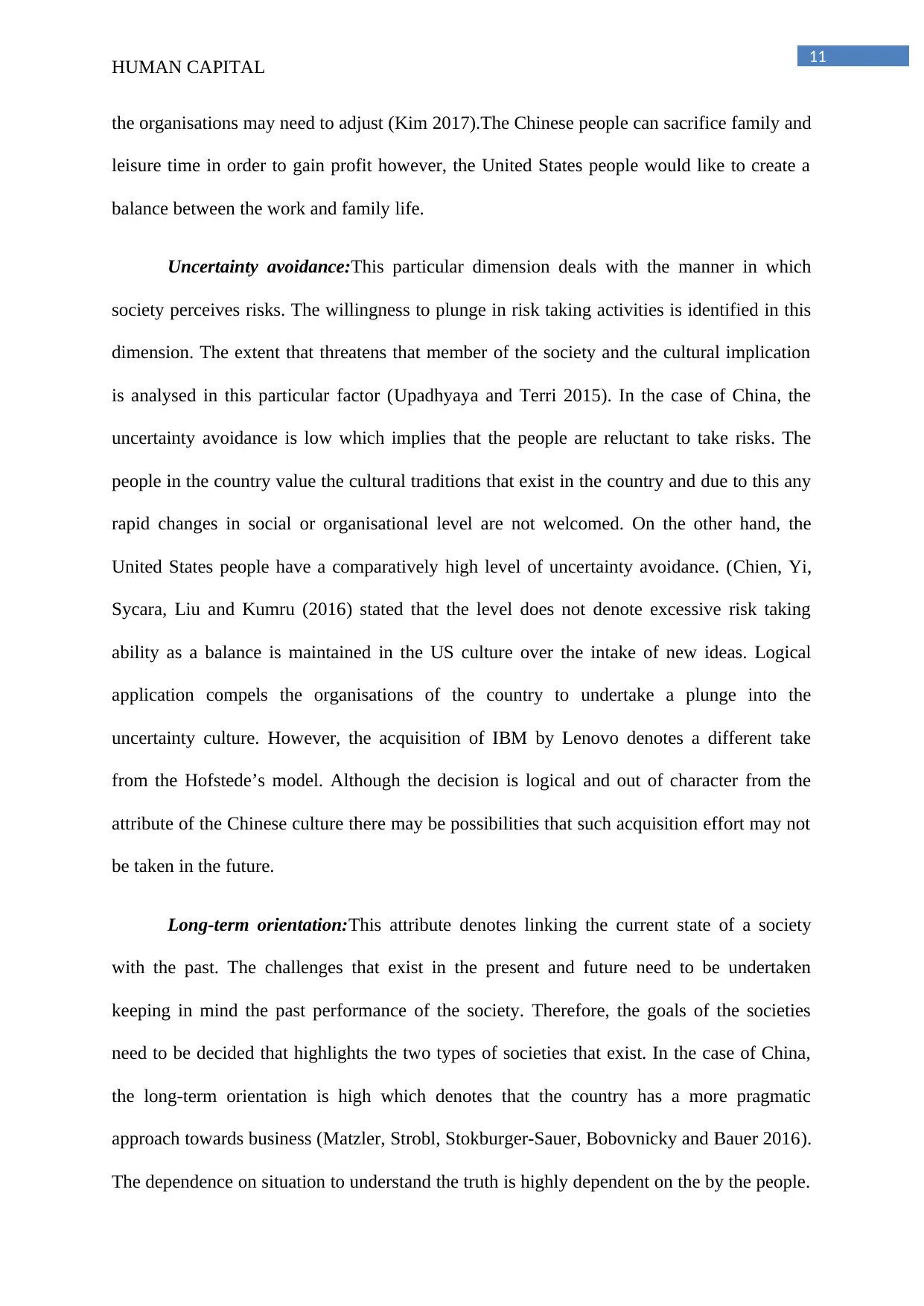
11
HUMAN CAPITAL
the organisations may need to adjust (Kim 2017).The Chinese people can sacrifice family and
leisure time in order to gain profit however, the United States people would like to create a
balance between the work and family life.
Uncertainty avoidance:This particular dimension deals with the manner in which
society perceives risks. The willingness to plunge in risk taking activities is identified in this
dimension. The extent that threatens that member of the society and the cultural implication
is analysed in this particular factor (Upadhyaya and Terri 2015). In the case of China, the
uncertainty avoidance is low which implies that the people are reluctant to take risks. The
people in the country value the cultural traditions that exist in the country and due to this any
rapid changes in social or organisational level are not welcomed. On the other hand, the
United States people have a comparatively high level of uncertainty avoidance. (Chien, Yi,
Sycara, Liu and Kumru (2016) stated that the level does not denote excessive risk taking
ability as a balance is maintained in the US culture over the intake of new ideas. Logical
application compels the organisations of the country to undertake a plunge into the
uncertainty culture. However, the acquisition of IBM by Lenovo denotes a different take
from the Hofstede’s model. Although the decision is logical and out of character from the
attribute of the Chinese culture there may be possibilities that such acquisition effort may not
be taken in the future.
Long-term orientation:This attribute denotes linking the current state of a society
with the past. The challenges that exist in the present and future need to be undertaken
keeping in mind the past performance of the society. Therefore, the goals of the societies
need to be decided that highlights the two types of societies that exist. In the case of China,
the long-term orientation is high which denotes that the country has a more pragmatic
approach towards business (Matzler, Strobl, Stokburger-Sauer, Bobovnicky and Bauer 2016).
The dependence on situation to understand the truth is highly dependent on the by the people.
HUMAN CAPITAL
the organisations may need to adjust (Kim 2017).The Chinese people can sacrifice family and
leisure time in order to gain profit however, the United States people would like to create a
balance between the work and family life.
Uncertainty avoidance:This particular dimension deals with the manner in which
society perceives risks. The willingness to plunge in risk taking activities is identified in this
dimension. The extent that threatens that member of the society and the cultural implication
is analysed in this particular factor (Upadhyaya and Terri 2015). In the case of China, the
uncertainty avoidance is low which implies that the people are reluctant to take risks. The
people in the country value the cultural traditions that exist in the country and due to this any
rapid changes in social or organisational level are not welcomed. On the other hand, the
United States people have a comparatively high level of uncertainty avoidance. (Chien, Yi,
Sycara, Liu and Kumru (2016) stated that the level does not denote excessive risk taking
ability as a balance is maintained in the US culture over the intake of new ideas. Logical
application compels the organisations of the country to undertake a plunge into the
uncertainty culture. However, the acquisition of IBM by Lenovo denotes a different take
from the Hofstede’s model. Although the decision is logical and out of character from the
attribute of the Chinese culture there may be possibilities that such acquisition effort may not
be taken in the future.
Long-term orientation:This attribute denotes linking the current state of a society
with the past. The challenges that exist in the present and future need to be undertaken
keeping in mind the past performance of the society. Therefore, the goals of the societies
need to be decided that highlights the two types of societies that exist. In the case of China,
the long-term orientation is high which denotes that the country has a more pragmatic
approach towards business (Matzler, Strobl, Stokburger-Sauer, Bobovnicky and Bauer 2016).
The dependence on situation to understand the truth is highly dependent on the by the people.
⊘ This is a preview!⊘
Do you want full access?
Subscribe today to unlock all pages.

Trusted by 1+ million students worldwide
1 out of 22
Related Documents
Your All-in-One AI-Powered Toolkit for Academic Success.
+13062052269
info@desklib.com
Available 24*7 on WhatsApp / Email
![[object Object]](/_next/static/media/star-bottom.7253800d.svg)
Unlock your academic potential
Copyright © 2020–2025 A2Z Services. All Rights Reserved. Developed and managed by ZUCOL.




